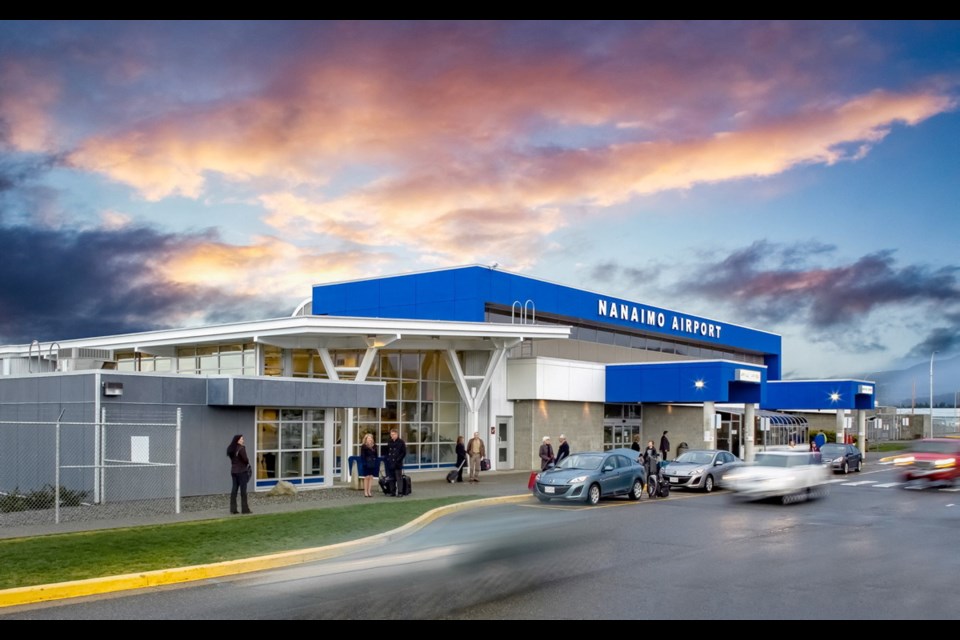Construction will start next month on the first phase of a 20-year expansion at Nanaimo Airport, where passenger numbers have been setting records in recent years.
“We need to ensure that air transportation continues to be an economic engine for the Island, so we need to be continually growing our services,” Nanaimo Airport president Mike Hooper said Wednesday.
The first phase of the terminal expansion plan will cost $14 million, with the entire build-out pegged at about $55 million, depending on construction prices at any given time, he said.
“We are building phases as they are needed by our customers and as we have money available.”
Construction is being covered by $5 million from the Building Canada Fund, in which the federal and provincial governments each contribute an equal amount. Another $150,000 is coming from the B.C. Airport Assistance Program, and the Nanaimo Airport Commission is paying the remainder of the cost.
The commission was formed in 1990 as a non-profit organization. It owns 520 acres and it is under contract with the federal government to manage and operate the facility.
Tenders have been submitted for the first phase of expansion and the construction company will be chosen within three weeks, Hooper said. “We should be breaking ground in March.”
Plans for the first phase will add 14,000 square feet to the 23,680-square-foot terminal building. Hooper anticipates that work to be completed by fall 2019.
The project will see more space in the area where baggage is X-rayed. “It will allow folks to move through security faster,” Hooper said.
The airport ran into technical difficulties on Wednesday, increasing security wait times. Reports said the machine used to X-ray bags went out of service. The airport asked passengers to arrive early and said it was working to resolve the problem.
As well, the boarding lounge is growing. At busy times, adjacent rooms are opened to cope with the number of waiting passengers, Hooper said. The number of seats will rise to about 320 from the current 140.
The boarding lounge will be improved and a food-retail outlet will be added. Currently, there are vending machines and a kiosk.
Airport volunteers will be on hand to assist travellers during the project.
Expansion beyond the first stage will take place as required. For example, if direct flights to sunny locations are added, then a larger customs facility will be needed, Hooper said.
The overall scheme for the terminal would see it increase to 70,395 square feet within 20 years. The 1991 terminal was previously doubled in size in 2012. Expansion is being driven by the increasing number of passengers passing through the airport.
In 2017, numbers topped 358,000 — a 110 per cent increase in six years, Hooper said. “We’ve been hitting records every year for six years.”
WestJet and Air Canada currently serve Nanaimo. Passengers can fly non-stop to Vancouver, Calgary and Toronto.
Along with a healthy local economy, Hooper points to the addition of an instrument landing system and a longer runway (now 6,600 feet) eight years ago, allowing the airport to handle larger aircraft. Those bigger planes do not make regular visits, but come in as charters.
Hooper is planning ahead, preparing to keep up with expected demand. “As we go forward and our population grows in the region, we will see those larger aircraft.”
About 70 per cent of passengers are leisure travellers and 30 per cent business passengers, Hooper said. Vancouver Island University is the source of most passengers, including professors, students and families.
Federal regulations require that within two years, a new $1-million fire hall and a second $900,000 emergency fire-response vehicle must be in place, Hooper said. Money will come from the federal Airport Capital Assistance Program.
Also on the to-do list are plans to increase the 296,513-square-foot parking lot by another 182,986 square feet. The 265,588-square-foot apron (the space used to park aircraft) is to be expanded by 215,278 square feet. Costs have not been developed for the parking and apron work, Hooper said.
Road expansion is also planned. There are currently 7,194 feet of roads and Hooper expect to see another 8,667 feet added.
Once construction starts, there will be about 150 people working at the airport on any given day. That includes the terminal staff, construction workers and employees at businesses on its lands, such as air cargo services.



